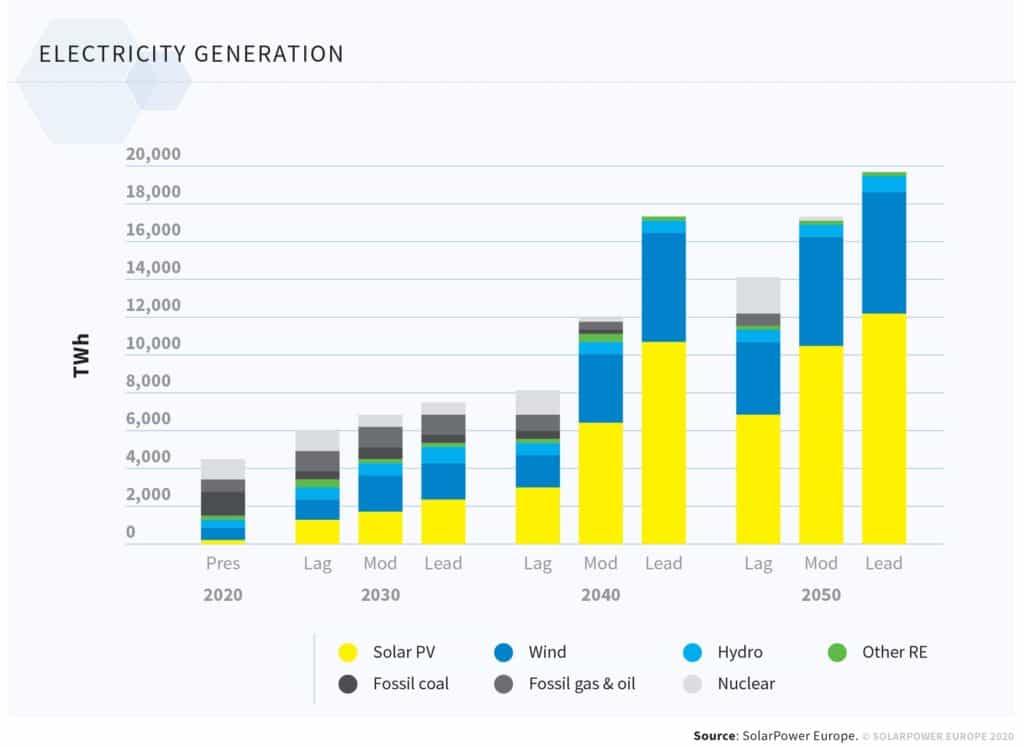from pv magazine Germany
A report from Solarpower Europe and the Lappeenranta-Lahti University of Technology (LUT), “100% Renewable Europe: How to make Europe’s energy system climate neutral before 2050” is the first study to model a fully renewable path to achieving climate neutrality for the European energy system by the middle of the century.
Three transformation paths with different levels of ambition are compared and the finding is: a less ambitious path is more expensive for European society and its economy.
- In the so-called “leadership scenario,” 100% renewable energy will be reached as early as 2040.
- The cheapest 100% renewable scenario, considering the cumulative costs, is the “moderate scenario” which reaches the 100% goal by 2050.
- In the “laggard scenario,” the authors assume a share of 62 percent renewable energies by 2050, with which Europe would neither achieve climate neutrality nor achieve its Paris climate goals.
A central component of the study and the first two scenarios is that solar’s share of electrical generation will grow to 60 percent in Europe by 2050 and that starting in 2030, solar energy will become the main pillar of the energy system. Wind power is an important pillar and will remain the leading renewable energy source through 2030. With the increasing share of photovoltaics and wind power, a further expansion of storage, especially after 2030, is of enormous importance. In addition, green hydrogen is essential for sector coupling and climate neutrality in Europe, although development in this sector will only start to pick up in 2030.
According to the authors, greenhouse gas emissions in Europe can be reduced to zero by 2040 in the “leadership scenario” compared to 1990. In the second renewable scenario, the goal would be reached by 2050. In the “laggard” scenario, on the other hand, the study sees a 53 percent decline in GHGs by 2030. Around 800 million tons of CO2 would still be emitted in Europe in 2050.
“Following the publication of the European climate law, six member states asked the European Commission to include a 100% renewable energy scenario in the Commission’s energy and climate projections for 2050,” said Luxembourg Minister of Energy Claude Turmes. The study shows the advantages of such a 100% renewable energy path. At the same time, the European energy system could be made more resilient, according to Turmes.
“Solar energy will generate more than 60% of European electricity by 2050. However, this must go hand-in-hand with a high degree of electrification and sector integration, which is essential for achieving a 100% renewable and integrated energy system,” said Michael Schmela, executive advisor and head of market intelligence at Solarpower Europe. It also proposes that starting in 2030, renewable hydrogen will contribute to the decarbonization of the heating and transport sector and will become the second most important energy source in Europe — behind photovoltaics.
The report also makes various demands on politicians to implement one of the ambitious renewable scenarios. The administrative and financial prerequisites would have to be created to enable photovoltaics and wind power to grow in the terawatt range.
“As a first step, the EU should legally set the goal of climate neutrality and review the EU’s greenhouse gas target for 2030 to meet the Paris Agreement of 1.5 degrees Celsius,” said Aurélie Beauvais, political director of Solarpower Europe. Priority should be given to the expansion of photovoltaics and wind power in the electricity sector by 2030. This would pave the way for the development of low-cost hydrogen solutions from 2030. “We also call for the establishment of a committee to implement the ‘Clean Energy Package Implementation Body’ to remove the legal and administrative framework that remains the main obstacle to the use of photovoltaics and renewable energies in Europe,” added Beauvais .
This content is protected by copyright and may not be reused. If you want to cooperate with us and would like to reuse some of our content, please contact: editors@pv-magazine.com.









By submitting this form you agree to pv magazine using your data for the purposes of publishing your comment.
Your personal data will only be disclosed or otherwise transmitted to third parties for the purposes of spam filtering or if this is necessary for technical maintenance of the website. Any other transfer to third parties will not take place unless this is justified on the basis of applicable data protection regulations or if pv magazine is legally obliged to do so.
You may revoke this consent at any time with effect for the future, in which case your personal data will be deleted immediately. Otherwise, your data will be deleted if pv magazine has processed your request or the purpose of data storage is fulfilled.
Further information on data privacy can be found in our Data Protection Policy.